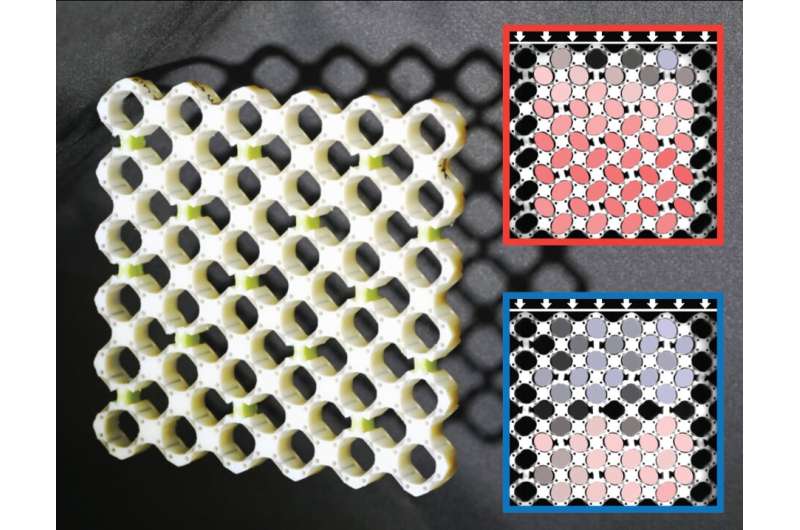Metamaterials offer multifunctional materials for engineering

In recent years, the popularity of metamaterials has increased significantly. These materials are not found in nature or made using chemical reactions, but are designed geometrically in the physics lab. Metamaterials can be given special, often counterintuitive, properties. For the first time, physicists have now developed a toolbox to create materials that feature multiple such properties simultaneously. The research was published in the Proceedings of the National Academy of Sciences this week.
The research that led to the new materials was carried out by physicists Aleksi Bossart, David Dykstra, Jop van der Laan and Corentin Coulais from the University of Amsterdam. Using the toolbox, they created a material which changes its behavior as it is compressed either quickly or slowly. New materials like this can be very useful for shock absorbers in cars, for construction materials that can withstand earthquakes or flow regulating pressure valves.
Designer materials
Metamaterials are engineered materials with extraordinary properties. These properties come from their geometrical structure rather than their chemical composition. The intricacy of metamaterials lies in their design, not in how they are constructed: once the correct geometry is known, a 3D printer is often sufficient to make the material. Over the past few years, physicists have become more and more skillful in designing metamaterials with interesting properties. For example, materials can now be engineered to be very light and very stiff, or to exhibit strange mechanical behavior—they can shrink sideways when compressed, whereas ordinary materials expand, or they can even behave as programmable shape-changers.
Though not always easily carried out, the idea therefore seems simple: if you need a material with a specific property, find a clever physicist to design it for you. But what if you need a material that hastwospecial properties? And what if, depending on the circumstances, you want to be able to switch between the two properties?
Two functionalities
This is precisely the type of question one encounters when, for example, searching for materials that can withstand earthquakes. Such a material should respond very differently to the small vibrations that are present in a building's everyday life than it should when experiencing a shock due to an earthquake. With applications like this in mind, Bossart, Dykstra, Van der Laan and Coulais set out to design materials that have not one but multiple functionalities within a single structure.
In particular, they managed to create metamaterials that can either shrink or expand on the side when compressed, depending on how fast the compressing force is exerted. An example of such a material is shown in the image above: the key to the material's functionalities is in the pattern of its holes. When pressure is exerted, the holes collectively deform, but this collective behavior is different when the pressure is exerted slowly than when it is exerted quickly.
New metamaterials like this one could be very interesting for all sorts of industrial applications. One application would be in earthquake-resistant building materials, but the metamaterials could also lead to other energy absorption applications—think of shock absorbers in cars—or to novel adaptable devices in robotics including flow regulating pressure valves.
More information: Aleksi Bossart et al, Oligomodal metamaterials with multifunctional mechanics, Proceedings of the National Academy of Sciences (2021). DOI: 10.1073/pnas.2018610118
Journal information: Proceedings of the National Academy of Sciences
Provided by University of Amsterdam




















